During the past three weeks, life has been progressively more manic, as is normal in Lochaber at this time of year. Usually in February, the weather gets amazing for almost all types of climbing, and this season has been especially good. Trying to get anything else done apart from new routes is quite a challenge and usually involves late nights and early starts. Maybe the rain will return by March and I’ll take a rest day?!
When I got home from Spain, I was pretty keen to get into the hills. I started off with a day on the Ben with Kev and could hardly walk the next morning. However, my ankle seemed to continue to adapt and I went back up a couple more times. Since both of us were only really able to walk short distances with big packs, we opted for the CIC hut cascades. Kev cruised the icefall.
Next up I went to a ridiculous boulder roof in the glen. It’s quite low to the ground and fully horizontal. An acquired taste maybe - a bit like a darker version of the darkness cave in Magic Wood. There’s 25 feet of horizontal climbing on brutal crimps in there, with three logical starts. The shortest link will be Font 8aish and the full trip looks like solid Font 8b+. I couldn’t imagine doing it at the moment, but I did do about half the moves on my first session.
I’ve also been trying a bit of running with mixed results. I did some trail and hill runs up to 12 miles and was getting on fine. Then one evening I did some short fast sections since it was already getting dark after the climbing. I misjudged the angle of a boulder on the trail and hit the ‘no go zone’ in my ankle hard and let out a yelp. It’s been worse ever since, which is rather depressing. I can’t really do much except hope I’ve not done more damage. Not good.
Ardverikie deer forest. Here be boulders...
The next day I was getting pain even walking which put a downer on an otherwise great day out in Ardverikie Forest returning to a boulder I’d found on a run two years ago. I went to look at a roof that I’d estimated about Font 8b. But to actually try, it felt way harder. I pretty much gave up, although to be fair I wasn't in the most positive frame of mind, and the easterly was biting cold. It was a series of savage first joint undercuts in a roof with microscopic granite crystals level with your head for feet. A bit like doing harder versions of the Hubble undercuts crux about 5 times in a row. Maybe I’ll make a model on my board and try it once more in the spring.
The solid river Nevis today, near Steall.
Dan cleaning new problems, new boulder in Glen Nevis today.
Today saw some great new problems get done after a monster cleaning. I'll take some pictures of them next time. I did the problems almost in the dark since we were brushing for a lot of the afternoon. The boulder has probably 15 problems to do from Font 5 to 8A+ on the usual lovely honeycomb Glen Nevis schist. I hope my arms aren't too tired for tomorrows session back on the Ben. Off to sleep!
To most men , experience is like the stern light of a ship which il-luminates only the track it has passed. (Samuel Tylor Coleridge, British poet)
Tuesday, September 30, 2008
Recent adventures on rock
Broody hen
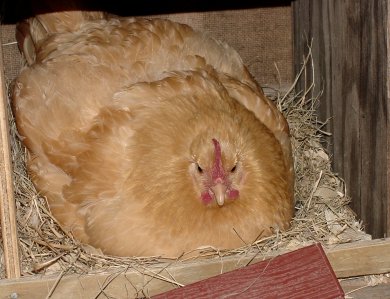
She didn't seem very dedicated at first. She kept changing her mind about which eggs she wanted to sit on.
So we put her to sitting on some golf balls for a while.
She wouldn't give up though, and finally settled down into a spot she liked.
We relented and gave her three eggs to try hatching.
Not listening to the advice of the folks on my Homestead email list, I didn't mark the eggs. Next thing I knew, she was sitting on about 10 eggs.
When she was getting up briefly to go eat or drink, other hens were sneaking in and laying eggs in her nest.
The whole Star Trek "go where no one has ever gone before" concept is alien to chickens. They want to lay where lots and lots of hens have lain before. I've even seen then waiting in line.
I had to candle the eggs to see which ones she'd been sitting on longest. She would have left the others anyway, once the first chicks hatched out.
Instead of using a candle, I closed myself up in a dark closet with a flashlight, but it worked - I was able to see dark blobs in the eggs that had growing chicks inside them.
I'm trying not to get too excited about the whole thing. I've heard so many things from more experienced people that make me think this little experiment won't work. (Most people said that we needed to put her in a separate space if we wanted her to hatch out chicks, but there just wasn't anything available.)
I'll let you know how it turns out.
Friday, September 26, 2008
Salty Lemonade for Cycling

A few people have asked about the "salty lemonade" I mentioned in the previous post, and it's really very simple: When I fill my water bottles before a long ride, I add a pinch of salt and also some lemon juice to the water. In conjunction with snacks containing potassium, magnesium, calcium and sugar (i.e. bananas and milk), this mixture helps replenish electrolytes lost during cycling, especially in hot weather - which in turn can help prevent leg muscle cramps and lightheadedness that some experience on long and strenuous rides. Several cyclists I know prefer this method to consuming commercial sports drinks and gels, and it works for us.
Some points to consider about the Salty Lemonade:
. Do not overdo it on the salt. What I call a "pinch" I have seen defined as 1/8 of a teaspoon, which seems about right.
. The reason for adding lemon juice is mostly to balance out the salty taste. The sourness of it adds a nice refreshing element as well.
. Some like to fill one bottle with a weaker concentration of the mix than the other, alternating between them depending on how much they are sweating. Having bottles that look different from one another helps if you're going to do this.
. On long trips where you know you'll be able to refill your water bottle, you can also carry single-use salt packets to add to the fresh water.
. If you have been advised against a high-sodium diet, obviously consult with your physician prior to consuming anything like this (including commercially available sports drinks).
. As mentioned earlier, salty water alone is not enough to restore electrolytes, so make sure to supplement with appropriate snack foods. Bananas work best for me in this regard, and they are easy to eat while on the bike.
While many cyclists thrive on commercial sports drinks, others prefer more natural, home-made solutions and this can be one of them. Please feel free to share your own.
Sunday, September 21, 2008
The Batura 2.0 GTX?
This is just a teaser as the newest version of the Baturajust showed up on FED EX and I wanted to share!
Of course I think La Sportiva has some amazing designers. The newest version and the "Super Gater" clearly show cases that. We were addingVelcro and zippers on our Super Gaters back in the mid '70s. And most importantly none of us everhad a failure. Labor intensive so it adds to the price but a"good step" in the right directionI think.
More to come with a side by side comparison of the current BaturaEvo and this ne 2.0 version that will be available in the Spring of . But first impression? I had admittedly scoffed at the title "Batura 2.0." Adding Goretex to a old boot design doesn't make it a "new" boot. But it seems this is a total rebuild not just a glossy new paint job. It may look like a Batura but my impression is we have a new player here not just a few fancy cosmetic improvements. The under 900g weight per boot should be a head turner for those that keep count! And it would seem an even more rigid midsole than the previous boots. Hopefully I'll have some details from both Gore and La Sportiva to fill in the cracksI miss on the newest boot.
I've been duped by early prodction prototypes before. Hopefully this boot will prove that theory wrong.
Till then enjoy the pictures and think..... ICE :)

 GORETEX
GORETEX
 Batura II, Batura Evo, Phantom Ultra
Batura II, Batura Evo, Phantom Ultra
Of course I think La Sportiva has some amazing designers. The newest version and the "Super Gater" clearly show cases that. We were addingVelcro and zippers on our Super Gaters back in the mid '70s. And most importantly none of us everhad a failure. Labor intensive so it adds to the price but a"good step" in the right directionI think.
More to come with a side by side comparison of the current BaturaEvo and this ne 2.0 version that will be available in the Spring of . But first impression? I had admittedly scoffed at the title "Batura 2.0." Adding Goretex to a old boot design doesn't make it a "new" boot. But it seems this is a total rebuild not just a glossy new paint job. It may look like a Batura but my impression is we have a new player here not just a few fancy cosmetic improvements. The under 900g weight per boot should be a head turner for those that keep count! And it would seem an even more rigid midsole than the previous boots. Hopefully I'll have some details from both Gore and La Sportiva to fill in the cracksI miss on the newest boot.
I've been duped by early prodction prototypes before. Hopefully this boot will prove that theory wrong.
Till then enjoy the pictures and think..... ICE :)

 GORETEX
GORETEX Batura II, Batura Evo, Phantom Ultra
Batura II, Batura Evo, Phantom UltraFriday, September 19, 2008
A meeting at the Belgian Beer Museum in Brussels
Last month I was in Brussels for work and we had a meeting at the first floor of the Belgian Beer Museum (no. 10—the ‘den Gulden Boom’ building) on the Grote Markt (Grand Place). It’s a gorgeous building, it’s façade adorned with gilded elaborate designs.

 I’ve been to Brussels many times and I’ve seen Brussels at its loveliest. January wasn’t the best month though as I was met with rain and overcast.
I’ve been to Brussels many times and I’ve seen Brussels at its loveliest. January wasn’t the best month though as I was met with rain and overcast.
After the business meeting, we had a short beer history lesson in the basement of the building. Like many beer museum visits, I was really expecting a beer tasting session afterwards but unfortunately that did not happen, well, not at least right away. In fact I was quite confused on what's next on the agenda and I accidentally followed the women who were going to the chocolate making session held a few blocks away. I did not know that the beer tasting session is at the same building but at the first floor where we earlier had the business meeting. Oh well.
If I was to turn back the clock, I would have stayed for some beer. Anywho, I was able to taste a locally brewed trappist beer during lunch though.
And to be honest, I don’t think I will recommend quickly a visit to this Beer Museum. There are so many notable beer breweries and outstanding abbeys where a grand beer tour and tasting, are in my opinion, better experienced.
Here are a few pictures of the Grote Markt (Grand Place) on a gloomy January day.
 View to the Grote Markt / Grand Place from the Belgian Beer Museum building
View to the Grote Markt / Grand Place from the Belgian Beer Museum building
 Belgian beer history lesson
Belgian beer history lesson

 More buildings on Grote Markt / Grand Place.
More buildings on Grote Markt / Grand Place.
 The Belgian Parliament.
The Belgian Parliament.
One thing I would like to add... traffic in and around Brussels is HORRIBLE. The only advantage in going by car to Brussels is parking. A whole day parking costs only 14,50 EUR. For this amount you pay under 3 hours parking in Amsterdam and Utrecht.

 I’ve been to Brussels many times and I’ve seen Brussels at its loveliest. January wasn’t the best month though as I was met with rain and overcast.
I’ve been to Brussels many times and I’ve seen Brussels at its loveliest. January wasn’t the best month though as I was met with rain and overcast.After the business meeting, we had a short beer history lesson in the basement of the building. Like many beer museum visits, I was really expecting a beer tasting session afterwards but unfortunately that did not happen, well, not at least right away. In fact I was quite confused on what's next on the agenda and I accidentally followed the women who were going to the chocolate making session held a few blocks away. I did not know that the beer tasting session is at the same building but at the first floor where we earlier had the business meeting. Oh well.
If I was to turn back the clock, I would have stayed for some beer. Anywho, I was able to taste a locally brewed trappist beer during lunch though.
And to be honest, I don’t think I will recommend quickly a visit to this Beer Museum. There are so many notable beer breweries and outstanding abbeys where a grand beer tour and tasting, are in my opinion, better experienced.
Here are a few pictures of the Grote Markt (Grand Place) on a gloomy January day.
 View to the Grote Markt / Grand Place from the Belgian Beer Museum building
View to the Grote Markt / Grand Place from the Belgian Beer Museum building Belgian beer history lesson
Belgian beer history lesson
 More buildings on Grote Markt / Grand Place.
More buildings on Grote Markt / Grand Place. The Belgian Parliament.
The Belgian Parliament.One thing I would like to add... traffic in and around Brussels is HORRIBLE. The only advantage in going by car to Brussels is parking. A whole day parking costs only 14,50 EUR. For this amount you pay under 3 hours parking in Amsterdam and Utrecht.
Thursday, September 18, 2008
Cycling and the Beach
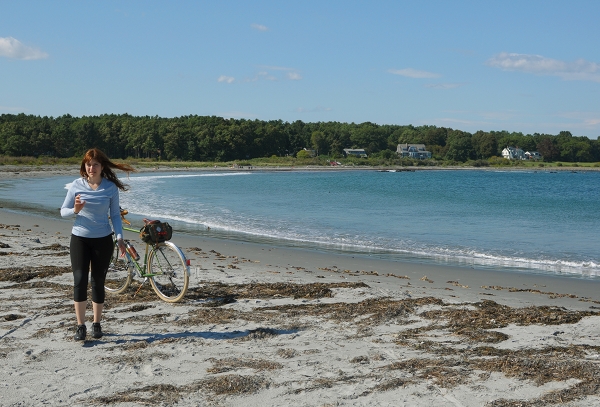 If you live in a beach town, it is easy to hop on a cruiser and pedal to the shore, have a swim, more or less dry off, and pedal home. But what about incorporating the beach into long, strenuous and hilly touring style-rides? This has been our dilemma when taking trips to Maine this summer. In the absence of folding bikes (and frankly, I don't think folding bikes would be appropriate for the terrain here), we strap our roadbikes to the car, and get around entirely by bike once we arrive to our "base" location. In rural Maine, everything is far away from everything else - at least by Boston standards - and it is normal for us to cycle 5-10 hilly miles from one destination to another, multiple times in a day. We often pass our favourite beach in the area, but swimming can seem like such a project when your bicycle bags are already stuffed with photo equipment and other things, and the beach has no changing rooms.
If you live in a beach town, it is easy to hop on a cruiser and pedal to the shore, have a swim, more or less dry off, and pedal home. But what about incorporating the beach into long, strenuous and hilly touring style-rides? This has been our dilemma when taking trips to Maine this summer. In the absence of folding bikes (and frankly, I don't think folding bikes would be appropriate for the terrain here), we strap our roadbikes to the car, and get around entirely by bike once we arrive to our "base" location. In rural Maine, everything is far away from everything else - at least by Boston standards - and it is normal for us to cycle 5-10 hilly miles from one destination to another, multiple times in a day. We often pass our favourite beach in the area, but swimming can seem like such a project when your bicycle bags are already stuffed with photo equipment and other things, and the beach has no changing rooms.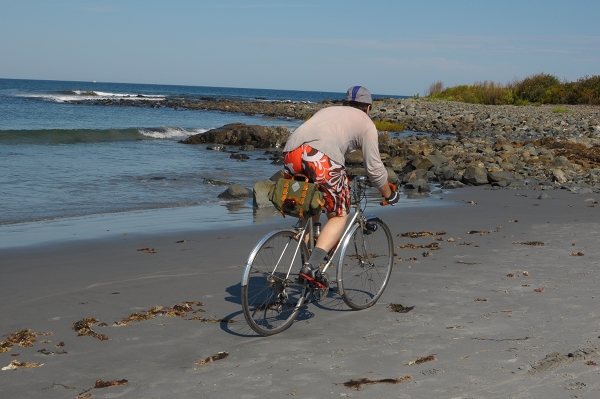 Plus, when a 10 mile ride with plenty of uphill lies between the beach and the nearest town where you could freshen up, believe me that you don't want any sand to be stuck in your body's crevices, and neither do you want to pedal in a bathing suit. The Co-Habitant has tried wearing his swim trunks on the bike, and regretted it.
Plus, when a 10 mile ride with plenty of uphill lies between the beach and the nearest town where you could freshen up, believe me that you don't want any sand to be stuck in your body's crevices, and neither do you want to pedal in a bathing suit. The Co-Habitant has tried wearing his swim trunks on the bike, and regretted it.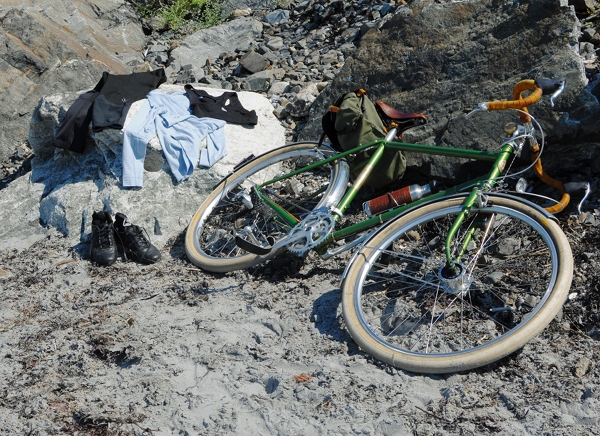 So here is my solution: I bring a bathing suit and a thin Pashmina or wrap instead of a towel. These take up almost no extra space in my saddle bag. Once at the beach, I remove my shoes and socks, wrap myself in the pashmina, and change into my bathing suit underneath it. If you don't have a pashmina or wrap, a long oversized t-shirt can work as a "changing tent" as well. After swimming, I "air dry" while either walking around or sitting on rocks (rather than sitting on sand); then I reverse the "changing tent" process. After this, the bathing suit can be wrung out, placed on a rock to dry off a bit, then placed in a plastic bag and packed away into the saddle bag together with the pashmina. After de-sanding my feet and putting my socks and shoes back on, I am ready to keep cycling. All this is a surprisingly low-hassle process.
So here is my solution: I bring a bathing suit and a thin Pashmina or wrap instead of a towel. These take up almost no extra space in my saddle bag. Once at the beach, I remove my shoes and socks, wrap myself in the pashmina, and change into my bathing suit underneath it. If you don't have a pashmina or wrap, a long oversized t-shirt can work as a "changing tent" as well. After swimming, I "air dry" while either walking around or sitting on rocks (rather than sitting on sand); then I reverse the "changing tent" process. After this, the bathing suit can be wrung out, placed on a rock to dry off a bit, then placed in a plastic bag and packed away into the saddle bag together with the pashmina. After de-sanding my feet and putting my socks and shoes back on, I am ready to keep cycling. All this is a surprisingly low-hassle process. Of course, one thing to make sure of before you stop at a beach like this, is that your water bottles are full. Also, never try to prop up your bike on the sand using a kickstand; carefully lay it down instead (drivetrain side up). Even if it seems as if the bike is stable on the kickstand, the sand's consistency changes with the wind and the tide, and the bike can easily fall. Oh, and if you go swimming, leave your bike as far from the water as possible - the tide can come in faster than you think!
Of course, one thing to make sure of before you stop at a beach like this, is that your water bottles are full. Also, never try to prop up your bike on the sand using a kickstand; carefully lay it down instead (drivetrain side up). Even if it seems as if the bike is stable on the kickstand, the sand's consistency changes with the wind and the tide, and the bike can easily fall. Oh, and if you go swimming, leave your bike as far from the water as possible - the tide can come in faster than you think!Swimming in the ocean and cycling are two of my favourite activities, and it feels wonderful to combine them. Interestingly, the ocean water seems to be a great complement to high-intensity cycling - relaxing the muscles and giving me extra energy to go on. Anybody else have this experience?
Tuesday, September 16, 2008
Still on the Road...
I had a great time at the Joslin Reunion. A nice little group of 26 devoured a catered traditional Thanksgiving dinner the Friday after Thanksgiving. They came from Virginia, Alabama, Indiana, Louisiana, New Mexico and, of course, Missouri. We all stayed at the same motel in Springfield which had a poolside atrium where we gathered most of the time. Kudos to Linda and Kathy for all their time and effort in making the arrangements.
A Joslin Reunion wouldn't be complete without an excursion to some historic family site. One of the places we visited was the area where Virgil Newton Joslin was born on February 21, 1891 “in a tent on the Carry farm in Polk County, Missouri, 12 miles from Bolivar, 4 miles from Dunnegan Springs, 6 miles from Fair Play, while his folks were making a trip by covered wagon.” Virgil is a son of Luther Marion Joslin who is a brother to my 2nd Great Grandmother Malissa Mariah Joslin Brubaker Bower.
George and Jim Joslin, sons of Virgil, were able to determine the approximate location of Virgil's birth from discussions with former and current owners of the property who stated that a small community was established in the area in the late 1800s. Apparently there was a wagon trail through the area. The current owner also told them that the trail was still visible but was not easy to find. Jim said he couldn't find the trail the last time he visited the site. Saturday was a cold, blustery day so we didn't take the time to try to find it then.
George scraped away the moss in an attempt to decipher the name and year engraved on the header stone over what used to be the doorway of the spring house. The name appears to be “C M Racksy” and the year may be 1879. If so, then the spring house may have been built about 12 years prior to Virgil's birth.



Other historic family sites we visited on Saturday were the White Chapel Cemetery, where Virgil and his wife Mary (Hutcheson) are buried, and the house where they lived in Springfield.
The majority of the people left Saturday afternoon or Sunday morning. George and his wife Lorene invited me to their house Saturday, so I stayed with them until this morning. We spent yesterday looking over their Joslin family files. It was a very good day!
It was raining when I left Springfield this morning but by the time I got to Joplin, the rain had stopped and the sky was starting to clear. After a brief stop for gasoline, it was on into Kansas. The sun came out and the clouds disappeared leaving blue skies behind. It even warmed up with the temperature getting up to 50 or so. A nice day for a drive in the country...
A Joslin Reunion wouldn't be complete without an excursion to some historic family site. One of the places we visited was the area where Virgil Newton Joslin was born on February 21, 1891 “in a tent on the Carry farm in Polk County, Missouri, 12 miles from Bolivar, 4 miles from Dunnegan Springs, 6 miles from Fair Play, while his folks were making a trip by covered wagon.” Virgil is a son of Luther Marion Joslin who is a brother to my 2nd Great Grandmother Malissa Mariah Joslin Brubaker Bower.
George and Jim Joslin, sons of Virgil, were able to determine the approximate location of Virgil's birth from discussions with former and current owners of the property who stated that a small community was established in the area in the late 1800s. Apparently there was a wagon trail through the area. The current owner also told them that the trail was still visible but was not easy to find. Jim said he couldn't find the trail the last time he visited the site. Saturday was a cold, blustery day so we didn't take the time to try to find it then.
George scraped away the moss in an attempt to decipher the name and year engraved on the header stone over what used to be the doorway of the spring house. The name appears to be “C M Racksy” and the year may be 1879. If so, then the spring house may have been built about 12 years prior to Virgil's birth.



Other historic family sites we visited on Saturday were the White Chapel Cemetery, where Virgil and his wife Mary (Hutcheson) are buried, and the house where they lived in Springfield.
The majority of the people left Saturday afternoon or Sunday morning. George and his wife Lorene invited me to their house Saturday, so I stayed with them until this morning. We spent yesterday looking over their Joslin family files. It was a very good day!
It was raining when I left Springfield this morning but by the time I got to Joplin, the rain had stopped and the sky was starting to clear. After a brief stop for gasoline, it was on into Kansas. The sun came out and the clouds disappeared leaving blue skies behind. It even warmed up with the temperature getting up to 50 or so. A nice day for a drive in the country...
Friday, September 12, 2008
Excess in the Bicycle Industry: Explanations and Implications
 [Aurumania crystal and gold track bike, image via forbes.com]
[Aurumania crystal and gold track bike, image via forbes.com]A couple of weeks ago,Forbespublished an article on"The World's Most Expensive Bikes". Readers have been sending me links to this article asking what I think, until finally I gave in and read it.
 [Golden Brompton, image viaforbes.com]
[Golden Brompton, image viaforbes.com]Glancing over the pictures, I noticed a strong trend for gold plating, crystals and diamonds - the usual when it comes to "luxury bikes". It made me wonder how much of these bicycles' price was due to ride quality (can they even be ridden?) and how much was due to the decorative elements.
 [KGS custom Parlee bicycle, image viaforbes.com]
[KGS custom Parlee bicycle, image viaforbes.com]I was also surprised to see that I actually know someone whose bicycle is on theForbeslist (not my cup of tea, this bike, but I understand that some people like to race on such things). Kevin Saunders ofKGS Bikesis an acquaintance (now also a sponsor, but initially an acquaintance) and the proprietor of a custom bicycle shop in San Antonio, Texas specialising in roadbikes that promise the "perfect fit." While admittedly high end, I did not think that most KGS bikes fetched the kinds of prices featured inForbes. So I asked Kevin about it. His answers were pretty straightforward, and I include them here in response to this discussion on Chic Cyclist(see the comments section):
Velouria: Kevin, how do you justify your $32,000 bicycle that was featured on the Forbes list?
Kevin Saunders: The bicycles in that price range that we have created were commissioned as one-offs. (They were also done prior to the Recession that started in .) A price of around $18.000-20,000 is where we find the line between premium (where more expensive components actually perform better) and luxury (where more expensive components may have a special finish or paint job but do not actually perform better).
V: So special paint can cost over $10,000?...
KS: Yes. Some fringe exotic components and one of a kind paint jobs (that includes not only the frame but all the components as well) can mean the differencebetween a $22,000 and a $32,000 bike. Our price for this is based on actual cost plus a reasonable markup.
V: And performance-wise, would a client even notice the ride quality difference between, say, a $10,000 bike, a $20,000 bike, and a $32,000 KGS bike?
KS: Performance wise, the difference between a $10,000 and a $20,000 bike is significant. There is almost no performance improvementto get to the next level (up to $32,000 or more). The only value above the$22,000 price pointis artistic.So, if I understand this correctly, even if you try to build a top of the line bicycle for competitive road cycling with full custom geometry and the highest performance available, the price will top out at $22,000. Anything beyond that will be mainly decorative. Keeping this in mind, consider that some of the bicycles on the Forbes list are priced at over $100,000.
 [Montante gold-plated bike, image viaforbes.com]
[Montante gold-plated bike, image viaforbes.com]So what are the implications of such bicycles existing? The "designer bicycle" not only goes beyond the typical prices of custom builders, but specifically presents itself as a luxury good - incorporating costly decorative materials and accessories fromhaute couturehouses. The"Fendi Abici Bike" I wrote about last year is one such example. There have also been similar products from Hermes and Chanel. Based on the feedback I have read about such bikes so far, cyclists in the blogging universe tend to be critical of excess in the bicycle industry. And this applies to accessories as much as to the bicycles themselves: Whenecovelowrote about a Brompton leather briefcase that retails for $600, some readers questioned that such an expensive bicycle accessory was allowed to exist.
 [Formigli track bike, image viaKGS Bikes]
[Formigli track bike, image viaKGS Bikes]My view however, is that the trend for "luxury bicycles" is great. Bring on the gold-plated framesets, the diamond-encrusted derailleurs, and the haute couture panniers! Even though I would not buy any of it, I am glad it is there. The trend for cycling-related luxury goods is a positive one, because it successfully combats that stereotype we all know: The stereotype of cycling being something people do because they either cannot afford a car, or are part of some weird fringe subculture. Rather than making people feel guilty about materialism - which is after all, a basic trait of human nature - this trend takes advantage of materialism to make bicycles appealing for people who otherwise would not have been drawn to them. Think about that the next time you curse that luxury car cutting into the bicycle lane. Wouldn't you rather they were riding a luxury bicycle?
Thursday, September 11, 2008
A drive on the Wild Side - Bear Country U.S.A.
We finally get to Bear Countrya drive thru wild life park. Elk - how do they keep their heads up with those antlers?? I guess the guy on the right is taking a break.
Elk - how do they keep their heads up with those antlers?? I guess the guy on the right is taking a break. Nice Rack
Nice Rack We were told Kirby was Poodle/Shepherd but now I think he was Artic Wolf
We were told Kirby was Poodle/Shepherd but now I think he was Artic Wolf Finally! We get to see a Big Horn Sheep
Finally! We get to see a Big Horn Sheep The Bear was a little wary of these Timber Wolves, can't blame him they have a crazed look on their faces.
The Bear was a little wary of these Timber Wolves, can't blame him they have a crazed look on their faces. Once again, the traffic in South Dakota is a Bear! Traffic was bearly moving!
Once again, the traffic in South Dakota is a Bear! Traffic was bearly moving!
 Areal roadside attraction.
Areal roadside attraction. Is it time to hibernate yet??
Is it time to hibernate yet?? Can't seem to get away from the Buffalo
Can't seem to get away from the Buffalo
 After the drive thru there is a small zoo with other animals, mostly babiesThe Lynx
After the drive thru there is a small zoo with other animals, mostly babiesThe Lynx A baby Arctic Fox
A baby Arctic Fox And then the Baby Bears
And then the Baby Bears They are so darn cute.
They are so darn cute.
 I want her job!
I want her job!

Nowwe can highly recommend it to the guests
We continue on to Rapid City to do some shopping and decide to stop at Hart Ranch a member's only Exclusive RV Park that our friends, Pam and Harold travel around with Fairs and Carnivals promoting. On our way out we are delayed by yet another traffic jam. Gary almost had a Cow - we were barely MOOOving!

Shopped will we dropped and then had Dinner at the Fire House Grill
Pass by our favorite Bar on the way home.
Till Later,
Meanwhile we keep on Trek'n
Melissa and Gary
 Elk - how do they keep their heads up with those antlers?? I guess the guy on the right is taking a break.
Elk - how do they keep their heads up with those antlers?? I guess the guy on the right is taking a break. Nice Rack
Nice Rack We were told Kirby was Poodle/Shepherd but now I think he was Artic Wolf
We were told Kirby was Poodle/Shepherd but now I think he was Artic Wolf Finally! We get to see a Big Horn Sheep
Finally! We get to see a Big Horn Sheep The Bear was a little wary of these Timber Wolves, can't blame him they have a crazed look on their faces.
The Bear was a little wary of these Timber Wolves, can't blame him they have a crazed look on their faces. Once again, the traffic in South Dakota is a Bear! Traffic was bearly moving!
Once again, the traffic in South Dakota is a Bear! Traffic was bearly moving!
 Areal roadside attraction.
Areal roadside attraction. Is it time to hibernate yet??
Is it time to hibernate yet?? Can't seem to get away from the Buffalo
Can't seem to get away from the Buffalo After the drive thru there is a small zoo with other animals, mostly babiesThe Lynx
After the drive thru there is a small zoo with other animals, mostly babiesThe Lynx A baby Arctic Fox
A baby Arctic Fox And then the Baby Bears
And then the Baby Bears They are so darn cute.
They are so darn cute.
 I want her job!
I want her job!Nowwe can highly recommend it to the guests
We continue on to Rapid City to do some shopping and decide to stop at Hart Ranch a member's only Exclusive RV Park that our friends, Pam and Harold travel around with Fairs and Carnivals promoting. On our way out we are delayed by yet another traffic jam. Gary almost had a Cow - we were barely MOOOving!

Shopped will we dropped and then had Dinner at the Fire House Grill

Pass by our favorite Bar on the way home.

Till Later,
Meanwhile we keep on Trek'n
Melissa and Gary
Meet My New Cycling Coach - Francesco!
I had mentioned in passing that I brought a vintage frame with me from my last stay in Austria to build up as a fixed gear road bike... Well, here is the result:
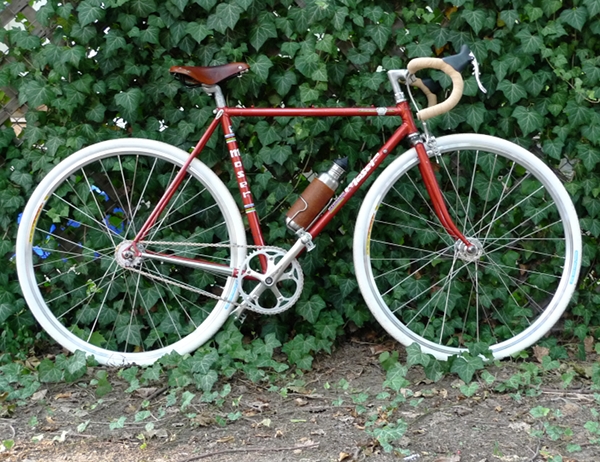 The frame is from a Francesco Moser "San Cristobal" roadbike, circa (I think) 1978. I got the frame from a friend of a friend and had a chance to try it when it was still a complete bike, so I knew it would fit me comfortably. The previous owner then stripped the frame of components and I mailed it to myself from Vienna, as this was by far the easiest option. It cost 20 Euros to send the frame from Vienna to Boston via the Austrian post. They instructed me to "wrap it so that it looks like a bike frame" rather than packing it in a bike box, and that is what I did. I wrapped the frame in bubble wrap, then in brown wrapping paper, and attached the address in several locations directly onto the wrapping. The package arrived at my door just over 2 weeks after I mailed it.
The frame is from a Francesco Moser "San Cristobal" roadbike, circa (I think) 1978. I got the frame from a friend of a friend and had a chance to try it when it was still a complete bike, so I knew it would fit me comfortably. The previous owner then stripped the frame of components and I mailed it to myself from Vienna, as this was by far the easiest option. It cost 20 Euros to send the frame from Vienna to Boston via the Austrian post. They instructed me to "wrap it so that it looks like a bike frame" rather than packing it in a bike box, and that is what I did. I wrapped the frame in bubble wrap, then in brown wrapping paper, and attached the address in several locations directly onto the wrapping. The package arrived at my door just over 2 weeks after I mailed it.
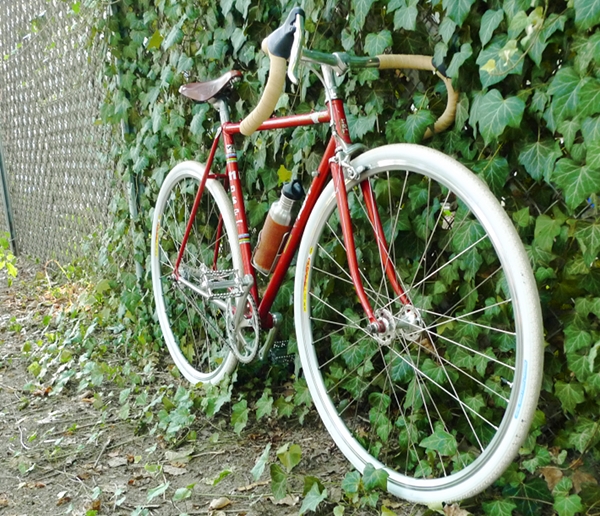 As you may have noticed, the Co-Habitant has turned into a bicycle mechanic this summer - to my appreciative delight, as I have neither the aptitude nor the time for it. He bought a bike stand, has accumulated the necessary tools for most jobs, and has been enjoying learning the ins and outs of bicycle repair. This was his first complete bike build, after he practiced with the fixed gear conversion on Marianne. As a mechanic he is meticulous, and this is reflected in the quality of the results. The bicycle is tight and smooth and noiseless and just the way I wanted it.
As you may have noticed, the Co-Habitant has turned into a bicycle mechanic this summer - to my appreciative delight, as I have neither the aptitude nor the time for it. He bought a bike stand, has accumulated the necessary tools for most jobs, and has been enjoying learning the ins and outs of bicycle repair. This was his first complete bike build, after he practiced with the fixed gear conversion on Marianne. As a mechanic he is meticulous, and this is reflected in the quality of the results. The bicycle is tight and smooth and noiseless and just the way I wanted it.
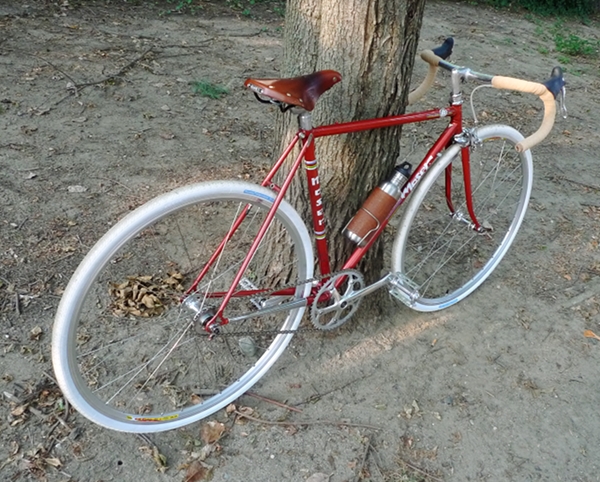 If you are interested in components, they include aSugino RD2 crankset, aMavic CXP2 wheelset, and whitePanaracer Pasela tires (700x28C). The seat post (manufacturer unknown), stem (Nitto), handlebars (GB) and brake (Shimano, model unknown) were recycled from various used/vintage sources. The brake levers are the same Tektro short reach I have on my Rivendell, and these are pretty much the only roadbike brake levers that I am actually able to squeeze with my poor hands. I have both brake levers despite there only being a front brake, because I like to keep my hands on the hoods. The right lever activates the brake; the left lever is inactive. Though I find it silly to have a "blank" brake lever, I cannot think of a better solution.
If you are interested in components, they include aSugino RD2 crankset, aMavic CXP2 wheelset, and whitePanaracer Pasela tires (700x28C). The seat post (manufacturer unknown), stem (Nitto), handlebars (GB) and brake (Shimano, model unknown) were recycled from various used/vintage sources. The brake levers are the same Tektro short reach I have on my Rivendell, and these are pretty much the only roadbike brake levers that I am actually able to squeeze with my poor hands. I have both brake levers despite there only being a front brake, because I like to keep my hands on the hoods. The right lever activates the brake; the left lever is inactive. Though I find it silly to have a "blank" brake lever, I cannot think of a better solution.
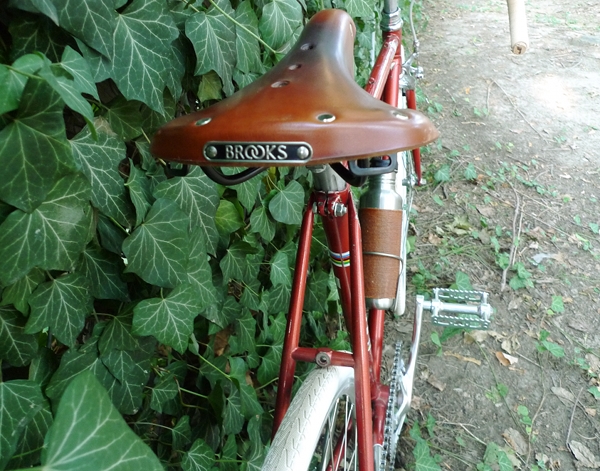 As for the lack of rear brake, the reason is two-fold. First, a rear brake in unnecessary on a fixed gear bike. And second, our tire choice made the rear clearance too tight to allow one. It looks in the picture as if the bridge is actually touching the tire, but I assure you it is not. There is enough clearance so that it is perfectly fine to ride, just won't fit a brake.
As for the lack of rear brake, the reason is two-fold. First, a rear brake in unnecessary on a fixed gear bike. And second, our tire choice made the rear clearance too tight to allow one. It looks in the picture as if the bridge is actually touching the tire, but I assure you it is not. There is enough clearance so that it is perfectly fine to ride, just won't fit a brake.
 This bicycle originally came with tubular wheels and narrow tires, so fitting it with 700C wheels andthe cushy white 28mm Paselas was really pushing the limits of its clearances. But we decided to go with them, because these tires are just a spectacular ride, as well as a safer choice for my pothole-ridden "training route". The larger wheels and tires also have the positive effect of raising the bottom bracket - which is a good thing for a fixed gear bike, as pedaling while leaning on a turn can potentially result in hitting the ground with the edge of a pedal. Needless to say, there will not be room for fenders on this bike. That is fine with me in this case, as the bicycle's purpose is entirely athletic. (Also, I think the "naked" white tires look quite good with the red frame.)
This bicycle originally came with tubular wheels and narrow tires, so fitting it with 700C wheels andthe cushy white 28mm Paselas was really pushing the limits of its clearances. But we decided to go with them, because these tires are just a spectacular ride, as well as a safer choice for my pothole-ridden "training route". The larger wheels and tires also have the positive effect of raising the bottom bracket - which is a good thing for a fixed gear bike, as pedaling while leaning on a turn can potentially result in hitting the ground with the edge of a pedal. Needless to say, there will not be room for fenders on this bike. That is fine with me in this case, as the bicycle's purpose is entirely athletic. (Also, I think the "naked" white tires look quite good with the red frame.)
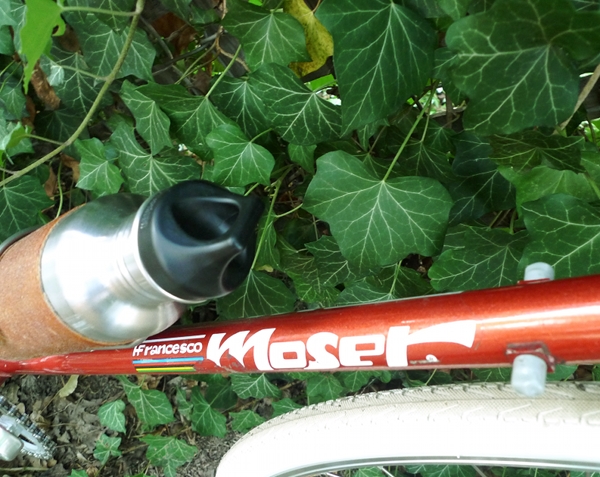 I should also mention, that while we built this bike up as a fixed gear, we did not file off any of the braze-ons or bosses. The rear derailleur hanger and the rear brake routing have been left as they were, and the downtube shifter bosses have been covered with these rubber "boss cozies" for safety and aesthetics.
I should also mention, that while we built this bike up as a fixed gear, we did not file off any of the braze-ons or bosses. The rear derailleur hanger and the rear brake routing have been left as they were, and the downtube shifter bosses have been covered with these rubber "boss cozies" for safety and aesthetics.
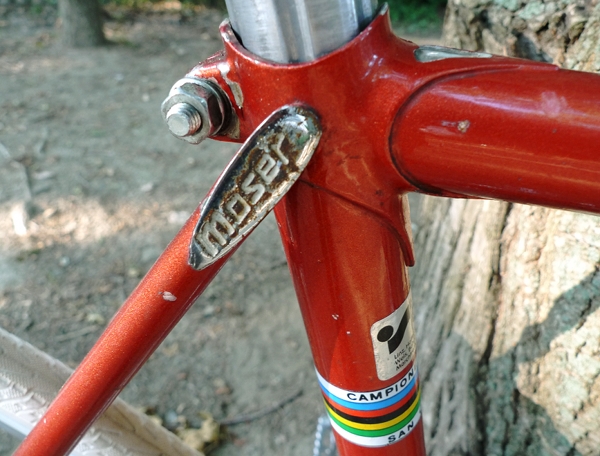 Francesco Moser frames are quite nice, and are well-regarded in Austria. I am told that this model is made of Columbus tubing, though there is no longer a decal testifying to this.
Francesco Moser frames are quite nice, and are well-regarded in Austria. I am told that this model is made of Columbus tubing, though there is no longer a decal testifying to this.
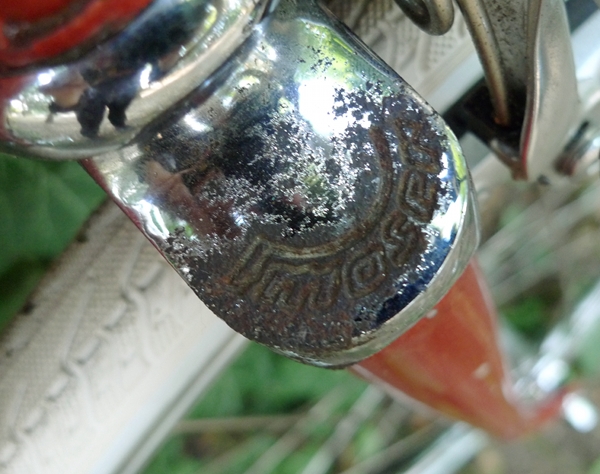 The frame is in great condition, except for some rust on these chrome parts. I plan to clean that up as soon as I determine what the safest method is.
The frame is in great condition, except for some rust on these chrome parts. I plan to clean that up as soon as I determine what the safest method is.
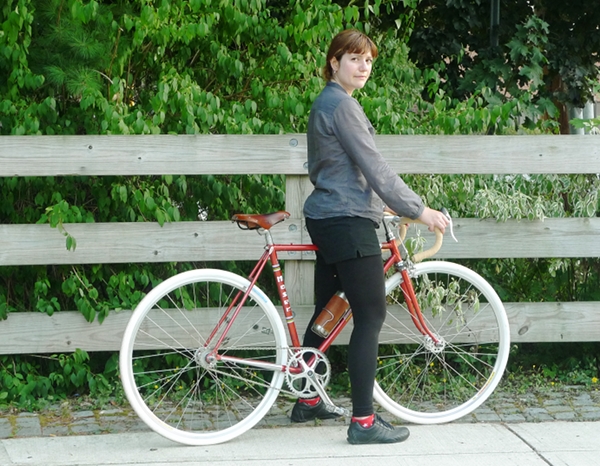 Now that I have given all the excruciating details regarding the bike, some are probably wondering why in God's name I needed a fixed gear roadbike. Well, I'll tell you. I had been planning this ever since having ridden that trackbike in Viennaand discoveringthat riding a fixed gear bike helps me build up my road cycling skills. It does that by addressing my biggest frustrations, which are balance and coordination. I have plenty of endurance to cycle fast for relatively long periods of time, but I suck at pretty much every other aspect of cycling (for instance, making turns and cycling closely to others at high speeds). The aspect of fixed gear cycling that most people find difficult (the constant pedaling) I am fine with, which makes it the perfect tool to help me with the other stuff.
Now that I have given all the excruciating details regarding the bike, some are probably wondering why in God's name I needed a fixed gear roadbike. Well, I'll tell you. I had been planning this ever since having ridden that trackbike in Viennaand discoveringthat riding a fixed gear bike helps me build up my road cycling skills. It does that by addressing my biggest frustrations, which are balance and coordination. I have plenty of endurance to cycle fast for relatively long periods of time, but I suck at pretty much every other aspect of cycling (for instance, making turns and cycling closely to others at high speeds). The aspect of fixed gear cycling that most people find difficult (the constant pedaling) I am fine with, which makes it the perfect tool to help me with the other stuff.
I have gone on two long rides on Francesco so far: a 26 mile ride with only very mild hills, and another 26 mile ride with steeper hills. Though the hilly ride was challenging, I have not experienced any pain or discomfort, despite this bicycle's aggressive geometry. Francesco seems like he will be a great cycling coach, and I look forward to getting to know him better.
 The frame is from a Francesco Moser "San Cristobal" roadbike, circa (I think) 1978. I got the frame from a friend of a friend and had a chance to try it when it was still a complete bike, so I knew it would fit me comfortably. The previous owner then stripped the frame of components and I mailed it to myself from Vienna, as this was by far the easiest option. It cost 20 Euros to send the frame from Vienna to Boston via the Austrian post. They instructed me to "wrap it so that it looks like a bike frame" rather than packing it in a bike box, and that is what I did. I wrapped the frame in bubble wrap, then in brown wrapping paper, and attached the address in several locations directly onto the wrapping. The package arrived at my door just over 2 weeks after I mailed it.
The frame is from a Francesco Moser "San Cristobal" roadbike, circa (I think) 1978. I got the frame from a friend of a friend and had a chance to try it when it was still a complete bike, so I knew it would fit me comfortably. The previous owner then stripped the frame of components and I mailed it to myself from Vienna, as this was by far the easiest option. It cost 20 Euros to send the frame from Vienna to Boston via the Austrian post. They instructed me to "wrap it so that it looks like a bike frame" rather than packing it in a bike box, and that is what I did. I wrapped the frame in bubble wrap, then in brown wrapping paper, and attached the address in several locations directly onto the wrapping. The package arrived at my door just over 2 weeks after I mailed it. As you may have noticed, the Co-Habitant has turned into a bicycle mechanic this summer - to my appreciative delight, as I have neither the aptitude nor the time for it. He bought a bike stand, has accumulated the necessary tools for most jobs, and has been enjoying learning the ins and outs of bicycle repair. This was his first complete bike build, after he practiced with the fixed gear conversion on Marianne. As a mechanic he is meticulous, and this is reflected in the quality of the results. The bicycle is tight and smooth and noiseless and just the way I wanted it.
As you may have noticed, the Co-Habitant has turned into a bicycle mechanic this summer - to my appreciative delight, as I have neither the aptitude nor the time for it. He bought a bike stand, has accumulated the necessary tools for most jobs, and has been enjoying learning the ins and outs of bicycle repair. This was his first complete bike build, after he practiced with the fixed gear conversion on Marianne. As a mechanic he is meticulous, and this is reflected in the quality of the results. The bicycle is tight and smooth and noiseless and just the way I wanted it. If you are interested in components, they include aSugino RD2 crankset, aMavic CXP2 wheelset, and whitePanaracer Pasela tires (700x28C). The seat post (manufacturer unknown), stem (Nitto), handlebars (GB) and brake (Shimano, model unknown) were recycled from various used/vintage sources. The brake levers are the same Tektro short reach I have on my Rivendell, and these are pretty much the only roadbike brake levers that I am actually able to squeeze with my poor hands. I have both brake levers despite there only being a front brake, because I like to keep my hands on the hoods. The right lever activates the brake; the left lever is inactive. Though I find it silly to have a "blank" brake lever, I cannot think of a better solution.
If you are interested in components, they include aSugino RD2 crankset, aMavic CXP2 wheelset, and whitePanaracer Pasela tires (700x28C). The seat post (manufacturer unknown), stem (Nitto), handlebars (GB) and brake (Shimano, model unknown) were recycled from various used/vintage sources. The brake levers are the same Tektro short reach I have on my Rivendell, and these are pretty much the only roadbike brake levers that I am actually able to squeeze with my poor hands. I have both brake levers despite there only being a front brake, because I like to keep my hands on the hoods. The right lever activates the brake; the left lever is inactive. Though I find it silly to have a "blank" brake lever, I cannot think of a better solution. As for the lack of rear brake, the reason is two-fold. First, a rear brake in unnecessary on a fixed gear bike. And second, our tire choice made the rear clearance too tight to allow one. It looks in the picture as if the bridge is actually touching the tire, but I assure you it is not. There is enough clearance so that it is perfectly fine to ride, just won't fit a brake.
As for the lack of rear brake, the reason is two-fold. First, a rear brake in unnecessary on a fixed gear bike. And second, our tire choice made the rear clearance too tight to allow one. It looks in the picture as if the bridge is actually touching the tire, but I assure you it is not. There is enough clearance so that it is perfectly fine to ride, just won't fit a brake. This bicycle originally came with tubular wheels and narrow tires, so fitting it with 700C wheels andthe cushy white 28mm Paselas was really pushing the limits of its clearances. But we decided to go with them, because these tires are just a spectacular ride, as well as a safer choice for my pothole-ridden "training route". The larger wheels and tires also have the positive effect of raising the bottom bracket - which is a good thing for a fixed gear bike, as pedaling while leaning on a turn can potentially result in hitting the ground with the edge of a pedal. Needless to say, there will not be room for fenders on this bike. That is fine with me in this case, as the bicycle's purpose is entirely athletic. (Also, I think the "naked" white tires look quite good with the red frame.)
This bicycle originally came with tubular wheels and narrow tires, so fitting it with 700C wheels andthe cushy white 28mm Paselas was really pushing the limits of its clearances. But we decided to go with them, because these tires are just a spectacular ride, as well as a safer choice for my pothole-ridden "training route". The larger wheels and tires also have the positive effect of raising the bottom bracket - which is a good thing for a fixed gear bike, as pedaling while leaning on a turn can potentially result in hitting the ground with the edge of a pedal. Needless to say, there will not be room for fenders on this bike. That is fine with me in this case, as the bicycle's purpose is entirely athletic. (Also, I think the "naked" white tires look quite good with the red frame.) I should also mention, that while we built this bike up as a fixed gear, we did not file off any of the braze-ons or bosses. The rear derailleur hanger and the rear brake routing have been left as they were, and the downtube shifter bosses have been covered with these rubber "boss cozies" for safety and aesthetics.
I should also mention, that while we built this bike up as a fixed gear, we did not file off any of the braze-ons or bosses. The rear derailleur hanger and the rear brake routing have been left as they were, and the downtube shifter bosses have been covered with these rubber "boss cozies" for safety and aesthetics. Francesco Moser frames are quite nice, and are well-regarded in Austria. I am told that this model is made of Columbus tubing, though there is no longer a decal testifying to this.
Francesco Moser frames are quite nice, and are well-regarded in Austria. I am told that this model is made of Columbus tubing, though there is no longer a decal testifying to this. The frame is in great condition, except for some rust on these chrome parts. I plan to clean that up as soon as I determine what the safest method is.
The frame is in great condition, except for some rust on these chrome parts. I plan to clean that up as soon as I determine what the safest method is. Now that I have given all the excruciating details regarding the bike, some are probably wondering why in God's name I needed a fixed gear roadbike. Well, I'll tell you. I had been planning this ever since having ridden that trackbike in Viennaand discoveringthat riding a fixed gear bike helps me build up my road cycling skills. It does that by addressing my biggest frustrations, which are balance and coordination. I have plenty of endurance to cycle fast for relatively long periods of time, but I suck at pretty much every other aspect of cycling (for instance, making turns and cycling closely to others at high speeds). The aspect of fixed gear cycling that most people find difficult (the constant pedaling) I am fine with, which makes it the perfect tool to help me with the other stuff.
Now that I have given all the excruciating details regarding the bike, some are probably wondering why in God's name I needed a fixed gear roadbike. Well, I'll tell you. I had been planning this ever since having ridden that trackbike in Viennaand discoveringthat riding a fixed gear bike helps me build up my road cycling skills. It does that by addressing my biggest frustrations, which are balance and coordination. I have plenty of endurance to cycle fast for relatively long periods of time, but I suck at pretty much every other aspect of cycling (for instance, making turns and cycling closely to others at high speeds). The aspect of fixed gear cycling that most people find difficult (the constant pedaling) I am fine with, which makes it the perfect tool to help me with the other stuff.I have gone on two long rides on Francesco so far: a 26 mile ride with only very mild hills, and another 26 mile ride with steeper hills. Though the hilly ride was challenging, I have not experienced any pain or discomfort, despite this bicycle's aggressive geometry. Francesco seems like he will be a great cycling coach, and I look forward to getting to know him better.
Subscribe to:
Comments (Atom)